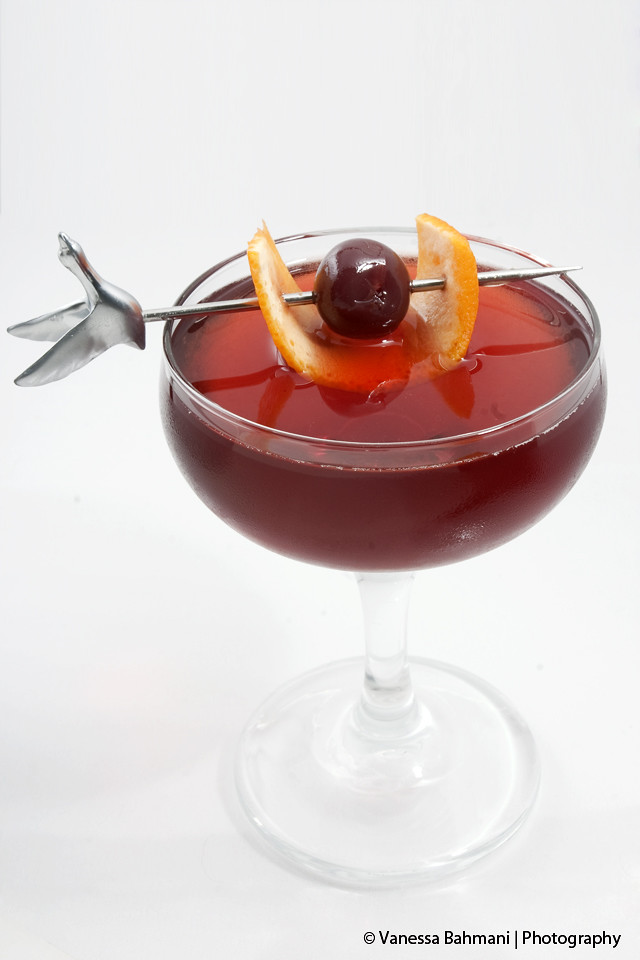Happy Hour: The Boulevardier

“Made of Win”
Bourbon is one of my favorite spirits to make and drink cocktails. Sadly, it is not used in many pre-Prohibition recipes due to rye whisky’s popularity during the golden age of cocktails. After Repeal, bourbon gained popularity as it became more available but was often just substituted for rye whisky in the Old Fashioned or Manhattan as the public’s taste for the milder Canadian ryes waned. Today, with rye whisky’s resurgence, craft bartenders and mixologists often sideline bourbon as a first choice when creating drinks. Well, I find it versatile and perfect to blend with citrus, amaro, herbs, other liqueurs with robust taste profiles. Further, bourbon is the most popular whiskey sold in the United States, which makes spreading the word about bourbon cocktails a good way to get more people into cocktail culture.
The latest cocktail to join the ranks of favorite bourbon cocktails is The Boulevardier. This drink is a rare gem considering it was created in the mid-1920s when bourbon was missing in action. The Boulevardier has swagger, depth, and successfully marries three distinct spirits – bourbon, Campari, and sweet vermouth into an unforgettable combination. In addition to being simple to craft, chances are most bars or home liquor cabinets have the three ingredients necessary to execute the cocktail so no need to search for esoteric cocktail ingredients. Add this to the list of reasons to spread the gospel of this libation.
THE DRINK
It is most appropriate that The Boulevardier’s rise to prominence with drinks aficionados has its origins in Ted “ Dr. Cocktail” Haigh’s game-changing cocktail book Vintage Spirits and Forgotten Cocktails: From the Alamagoozlum to the Zombie and Beyond (2003). I am not going to attempt to recite Haigh’s well-written history of the cocktail, so here is the long and short of it: Bartender Harry McElhorne, formerly principal bartender at New York’s Plaza Hotel bar, relocated to Europe during Prohibition, eventually opening the eponymous Harry’s American Bar in Paris. European ingredients like Campari and cocktails such as the Negroni were in high demand; so enterprising Harry added an American twist and brought bourbon into the equation.
During this period, bourbon became increasingly scarce on both sides of the pond since it was no longer produced in mass quantities. Thus, sophisticated bourbon cocktails like The Boulevardier gained a strong following among American expatriates such as writer/publisher Edward Erskine Gwynne. Haigh notes that Gwynne, a Vanderbilt family heir, edited a monthly bulletin for Yankee socialites abroad called The Parisian Boulevardier. Methinks there may be a chicken or the egg theory as to whether Gwynne preceded the cocktail’s naming or vice versa. Harry McElhorne memorializes the Boulevardier in his bartender’s manual called Barflies and Cocktails (1927), in which he credits Gwynne with the origin of the drink.
THE INGREDIENTS
The original proportions match the Negroni formula -- typically equal parts of each spirit. Haigh and others who have written about The Boulevardier recommend increasing the bourbon to 1.5 ounces and this proves to be a smart innovation especially when using strong vermouth like Carpano Antica or Cocchi plus Campari.
There is no mention of a specific brand of bourbon in the recipe so I experimented with two: Elijah Craig 12 years (47% Abv) and Buffalo Trace Straight Bourbon (45% Abv). Both Elijah Craig and Buffalo Trace hold up to the Campari and vermouth’s sweet herbal flavors keeping the bourbon taste front and center. Trace’s slightly spicy flavor does not diminish and plays well with Campari’s bitterness. Elijah Craig marries well with amaro as demonstrated in Sam Ross’ Paper Plane, and The Boulevardier is no exception. Campari balances the sweetness, so no aromatic bitters are necessary; it also adds a vermilion hue to the final product.
I prefer a vegetal sweet vermouth such as Cocchi Vermouth di Torino in this drink. Cocchi is the midway point between the robust almost chocolate flavors of Carpano Antica Formula and the lighter herbal Dolin Rouge. The Cocchi stands its ground against the bourbon sweetness and the bitter of Campari. Simply said, this mixture is made of win.
The Boulevardier
Adapted by Ted Haigh from Harry McElhone’s recipe
1.5 oz bourbon (we used Elijah Craig 12 Years Old)
1 oz sweet vermouth (we used Cocchi Vermouth di Torino)
1 oz Campari
Garnish: 1 Luxardo maraschino cherry and 1 orange peel
Tools: bar glass, bar spoon, Hawthorne strainer, Swiss peeler, cocktail glass
Method: Combine ingredients in mixing glass, add ice and stir until well chilled, strain into cocktail glass or coupe. Garnish with a maraschino cherry wrapped in an orange peel.
The Boulevardier hits all the marks for me personally as I love to “Italianize” cocktails with Amaro. So next time you are faced with the near impossible decision of Negroni or a Manhattan, make E. Erskine Gwynne smile from above and order The Boulevardier.
Insider’s tip: Rounding off the list of outstanding bourbon cocktails are The Kentucky Buck (bourbon, lemon juice, muddled strawberry, ginger beer, simple syrup, Angostura bitters) created by bartender Erick Castro, The Lion’s Tail (bourbon, pimento dram, lime juice, simple syrup, Angostura bitters), The Paper Plane (bourbon, Nonino Amaro, Aperol, lemon juice) created by bartender Sam Ross, and The Expatriate (bourbon, lime juice, simple syrup, muddled mint, Angostura bitters) developed by Vito Dieterle.
*Got a cocktail question? Reach Fredo on twitter @loungerati, email me at fredo(at)loungerati(dot)com, or simply drop me a comment below!
**Fredo Ceraso is the editor-at-large of the lounge lifestyle blog Loungerati.com. He is head cocktailian and a co-producer of The Salon parties. Fredo is a member of the USBG New York chapter and rolls drinks at many Lounge, Swing, Jazz Age, & Burlesque events in New York City.
